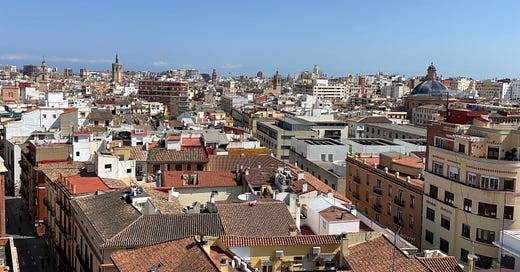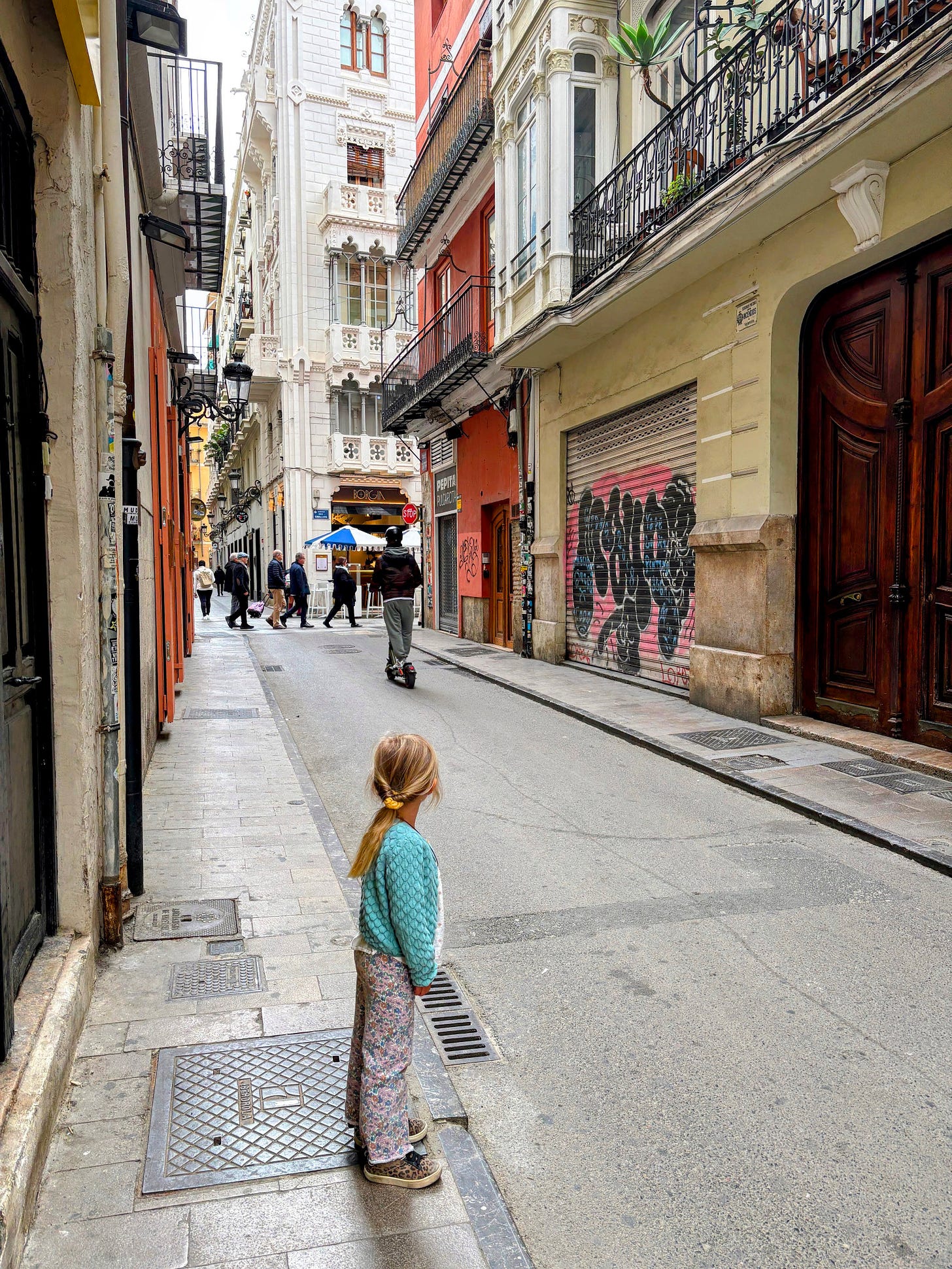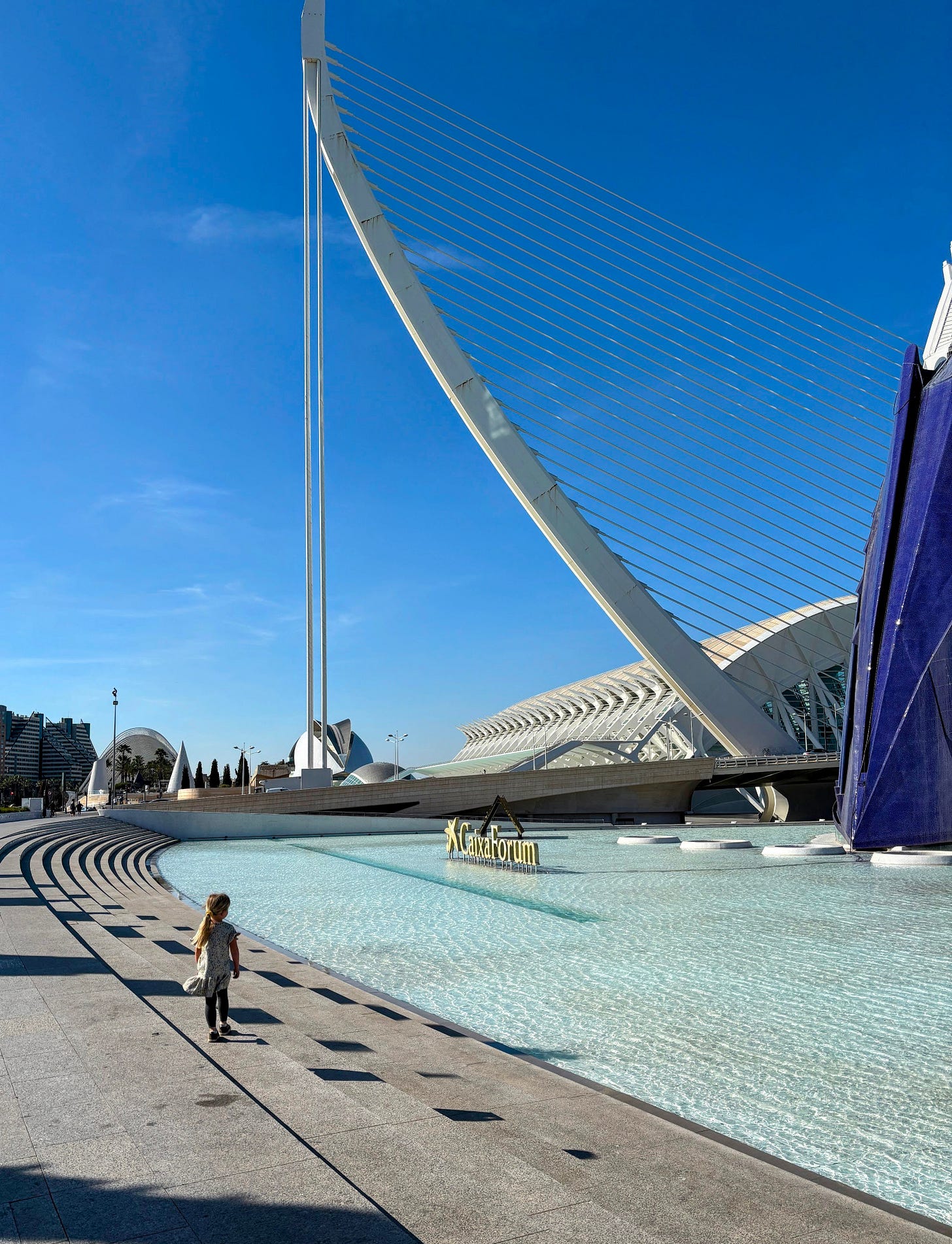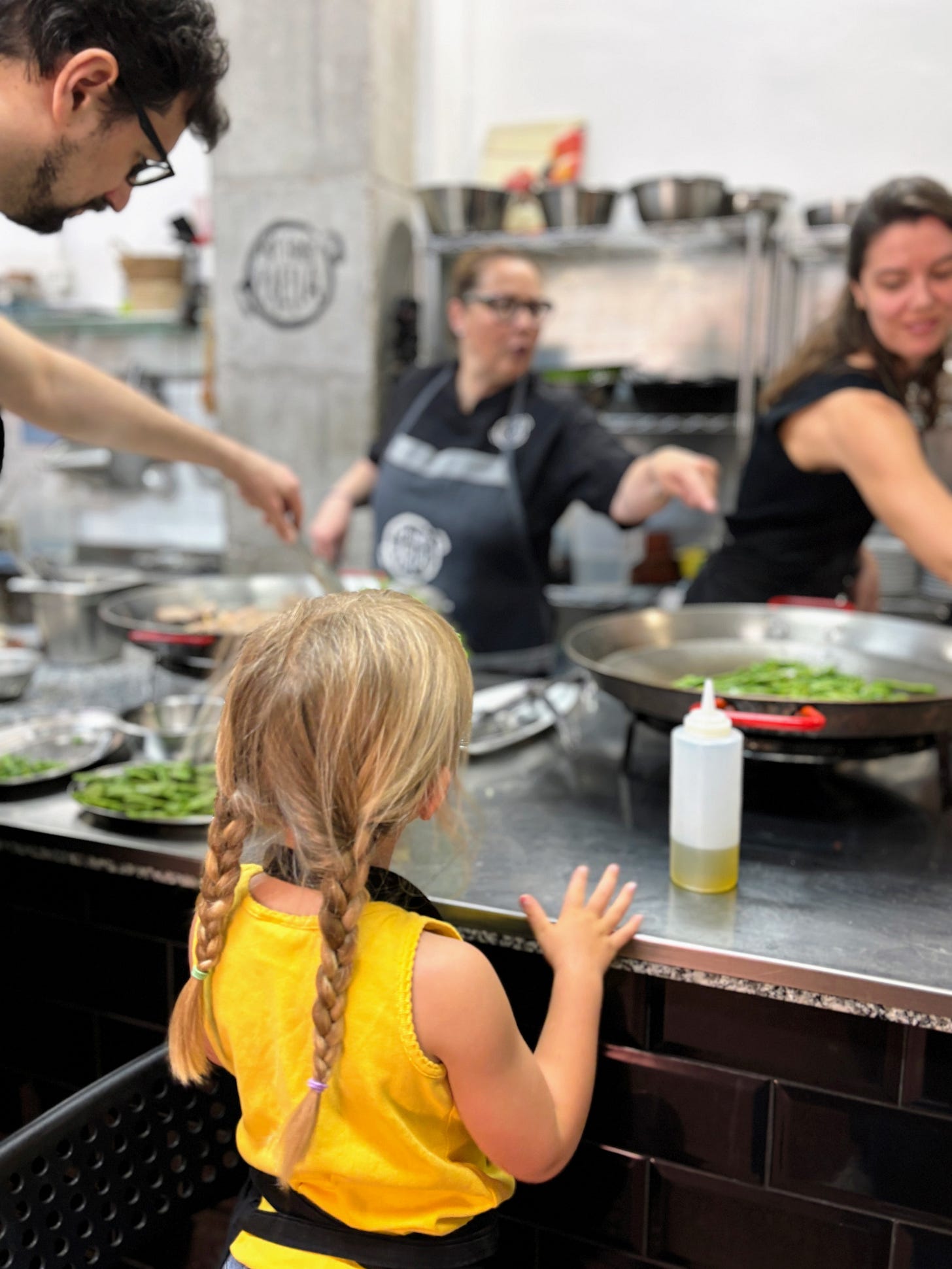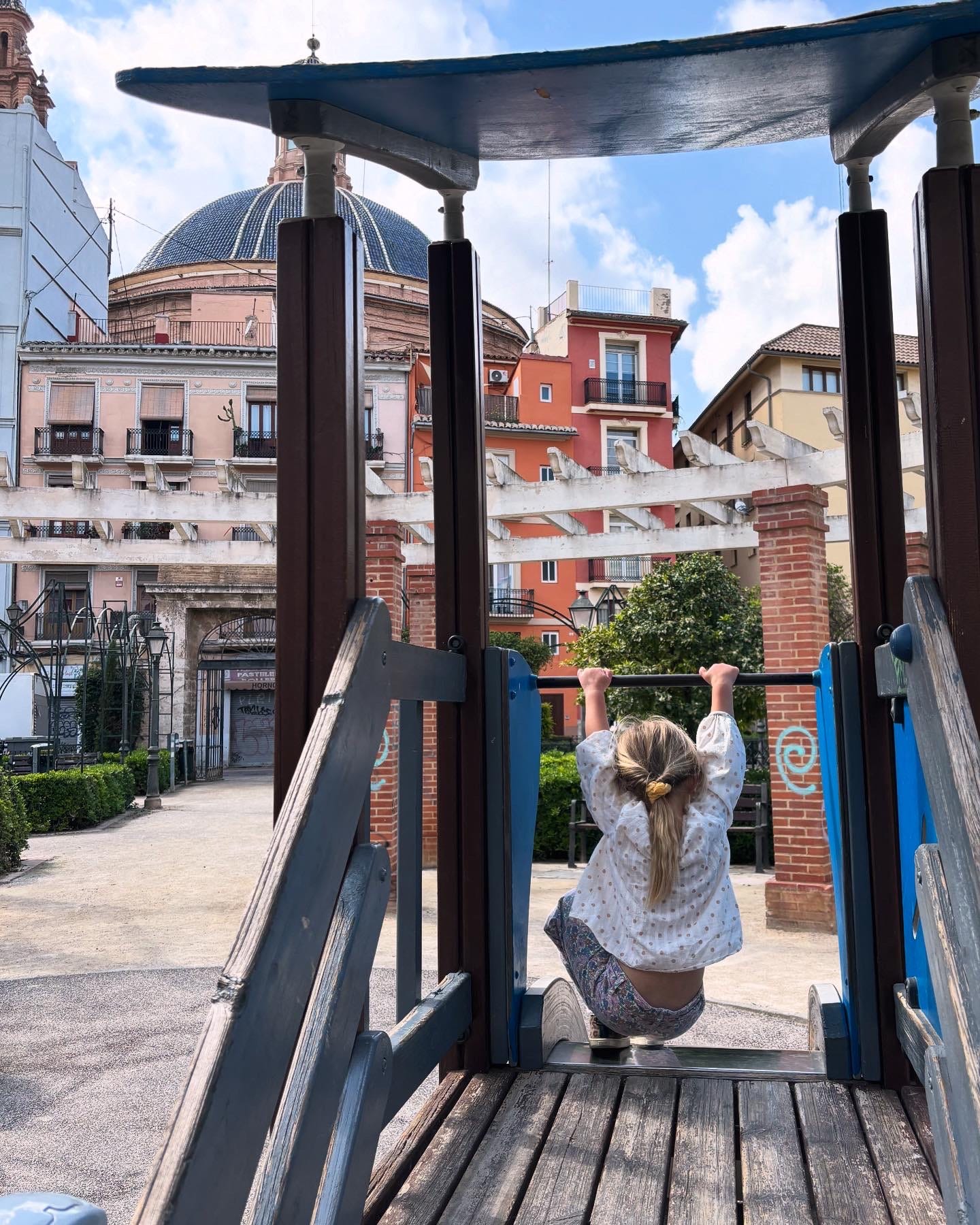Everything I Did in Valencia, Spain with my Preschooler
Europe’s largest aquarium, fairy-tale architecture, and a Gulliver-themed playground
“This looks like a place where a queen might dance,” I told my 4-year-old as we walked from an orange-tree-shaded courtyard into a grand hall. She started swaying and twirling around the marble floor as she hummed. I photographed the delicate spirals carved into the 50-foot columns. Warm afternoon light streamed in from the gargoyle-adorned windows. We were inside La Lonja de la Seda, a 15th-century building in Valencia, Spain that’s deemed a UNESCO World Heritage Site.
When it came time to choose a destination for my first trip solo with a child, I landed on Valencia, the third-largest city in Spain. It has gothic and modern architecture, a busy park running 6 miles through its center, Europe’s largest aquarium, Mediterranean beaches, and a massive playground inspired by “Gulliver’s Travels.”
The city’s public transit is excellent, which was a top priority because I refused to lug a bulky car seat around the airport or rent a car. (Bonus: My daughter considers bus and train journeys equivalent to amusement park rides.) The mild climate meant we wouldn’t need to stuff heavy layers in our shared carry-on. And at about the size of San Francisco, Valencia felt less intimidating than say London or Madrid.
The Historic Center
I enticed my daughter to tour the 1,000-year old landmarks scattered around the narrow streets of Ciutat Vella by describing them as castles. The medieval neighborhood is full of churches, plazas, fountains, and towers. She counted the twisting steps as we climbed Torres de Quart, the old city gates, and imagined we’d find Rapunzel at the top.
We explored the street art and cafes in the Ruzafa neighborhood (Bluebell Coffee Roasters made a nice breakfast), and I persuaded my daughter to stop in a few of the vintage shops with the promise of churros and chocolate. I introduced her to this delicacy at Buñolería El Contraste, where we ordered from employees in retro diner hats at a stainless steel counter. The establishment has been frying dough for more than a century.
Given my companion’s limited patience for museums, I opted to visit L’Etno, Valencian Museum of Ethnology on a Sunday to take advantage of the free entry and children’s workshops. From there, we went on to check out the nearby Centre del Carme Cultura Contemporània (free), a palatial art space in a 13th-century convent. We admired the brightly colored installations and the lush and peaceful patio.
The City of Arts and Sciences
Walking around the futuristic architectural complex City of Arts and Sciences felt like waking up in a sci-fi world. Imagined by Spain’s favorite nonconformist architect-engineer Santiago Calatrava, the looming white buildings sitting in vast shallow pools are reminiscent of alien organisms. We spent half a day at the Oceanogràfic aquarium, where the sharks and stingrays delighted my daughter and I couldn't stop filming the darting belugas and penguins (42€; 31€ kids). (Unfortunately, the aquarium holds captive dolphins that perform in popular shows, which we skipped.) The cultural complex also includes an interactive science museum, and we watched a documentary about the northern lights at Hemisfèric, the planetarium and IMAX theater modeled after a human eye (9€; 7€ kids).
“I think I have a crush on Spain,” my daughter said as she looked up at L’Agora, a building resembling a royal-blue-and-white spaceship that houses the museum CaixaForum Valencia (free). While she had no interest in the galleries, we took a break from the afternoon sun in the colossal atrium with a living wall made of 15,000 plants. It felt like being inside an exquisite monster. On weekends, the museum organizes sophisticated kids’ activities in its educational spaces, which we spent a quiet hour enjoying before catching a 60-minute play about a sneaker-wearing Mozart in the auditorium (6€).
Experiences
Valencians invented paella, and we found a cooking class with My First Paella to be a fun way to spend a half-day — and a chance for me talk to other adults from around the world (60€; 29€ kids). Our guide led us on a tour of the Ruzafa Market to purchase green and lima beans, saffron, and rosemary before our kitchen session, where we cooked over open flames on pans the size of mini trampolines. I impressed my daughter by eating snails, a traditional ingredient in the local version of the dish.
A food tour is a staple on our travel itineraries, and Indulge Spain welcomes all ages (78€; 68€ kids). Our vivacious host Vivi showed us around the Central Market of Valencia, an Art Nouveau gourmet temple. It’s the largest covered food market in Europe, with endless aisles of produce rainbows and startlingly fresh meats. (I get such a thrill seeing elegantly dressed Europeans shop for ingredients like freshly chopped live eels. It’s a reminder that there’s life beyond Costco hauls.) We sampled bocadillos, vegan croquetas, and jamon ibérico from black pigs that forage acorns.
Entertainment
I correctly predicted that a dance performance with spinning dresses would be a hit with my small counterpart. She ended up being the only child at Café del Duende’s 8pm flamenco show. But she was engaged (and pleased with the bottle of sparkling water she got with her drink ticket) and the employees were so gracious that I brushed off a couple sideways glances. We watched the musicians and dancers from tables set against the floor-height stage, where the passionate stomping shook our glasses. (10-20€. Line up 30 minutes before the doors open to get a seat.)
The whimsical, interactive performance at the old world marionette theater Teatro La Estrella charmed my daughter, who sat in one of the child-sized seats up front and wasn’t too bothered that it was in Spanish (9€, book online).
Outdoors
In my opinion, parks make a city. We frequently dropped in Jardín del Turia — a riverbed transformed into a long park — where we’d rest in the grass or she’d race around. All the joggers, cyclists, and picnickers created an atmosphere of leisure on evenings and weekends. If my travel partner was a more competent cyclist, I would have rented bikes to ride in the park and throughout the city, which is flat with designated bike lanes.
The city’s most famous playground, Parque Gulliver, a 250-foot-long fiberglass model of Gulliver tied down by Lilliputians, lies on the eastern side of Jardín del Turia. (We watched a snippet of an animated adaptation of “Gulliver’s Travels” before our trip to build excitement). It’s designed for bigger kids, with lots of cartoonishly steep ramps and slides (some actually 90 degrees — European surrealism?!) and slippery surfaces. I consider myself a pretty laidback mom, but the place had me on edge with a 4 year-old.
On the western end of Jardín del Turia, we found Parque Cabecera, a park-within-a-park. It has a pirate ship playground (with nice benches for grownups) and a lake with paddle boats.
Elsewhere in the city, it seemed that we came across a playground every few blocks. They were usually tiny and always graffiti covered, but they served their purpose, whether tucked behind a cathedral or a hospital.
On a sunny Saturday we checked two must-do’s off my preschooler’s list by taking the metro rain out to Malvarrosa Beach in the El Cabanyal neighborhood, where the vibe is more urban than resort. We walked along the Paseo Marítimo (towering rope climbing structures for her and people-watching for me), splashed around in the Mediterranean Sea, and stopped for gelato.
Food
Dining out with an American kid in a country that eats lunch around the time she’d usually get out of school and dinner well past her bedtime proved to be limiting. We often found ourselves at cafes when we needed to rest and refuel (Mestizo, Federal Valencia, Café ArtySana, Blackbird). At Mayan Coffees I broke my parental rule of no juice for zumo from freshly squeezed Valencia oranges.
We ate tasty tapas in the empty dining rooms of La Greta (the patatas bravas were perfection) and Labarra (on Gran Via, the place to see and be seen on a Friday night). At both restaurants, most tables were flagged for reservations well past 9pm. We tried horchata and fartons (a breadstick-shaped pastry) at the elegant Horchatería Santa Catalina. The humble personal pizzas at La Finestra were a hit with the preschooler, though I got the feeling it catered to the university crowd.
We also picked up items at the Consum supermarket by our apartment, where we found kefir from grass-fed cows and individually packaged goat yogurt. And in Spain, even the store-brand manchego, jamón serrano, and olives are excellent.
Tips and Observations:
We didn’t use cash at all on our trip. Even the food stalls and buses accepted mobile pay.
Valencia’s bus and metro systems are easy to navigate, with live wait times available on Google Maps. Screens in the buses indicate upcoming stops. Individual rides are 2€.
With 10 rides for 8€, the SUMA 10 travel card is the best transit value. It’s available at metro station kiosks and can also be used on the bus.
For airport transfers or trips around town, the ride-sharing app Cabify offers a car seat option.
BioParc Valencia is another family-friendly activity, but we skipped it since we’re members of the San Diego Zoo and Safari Park at home.


